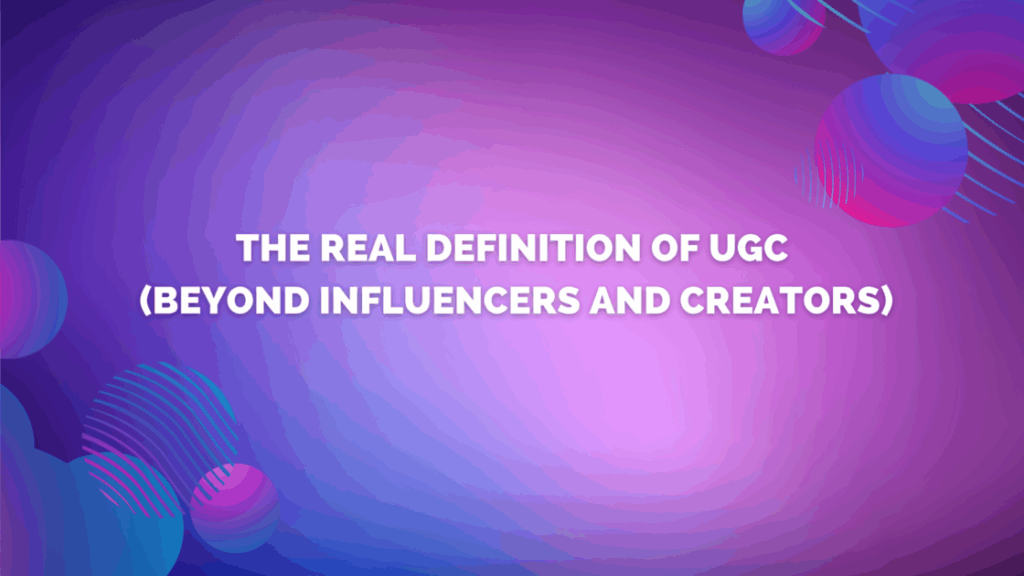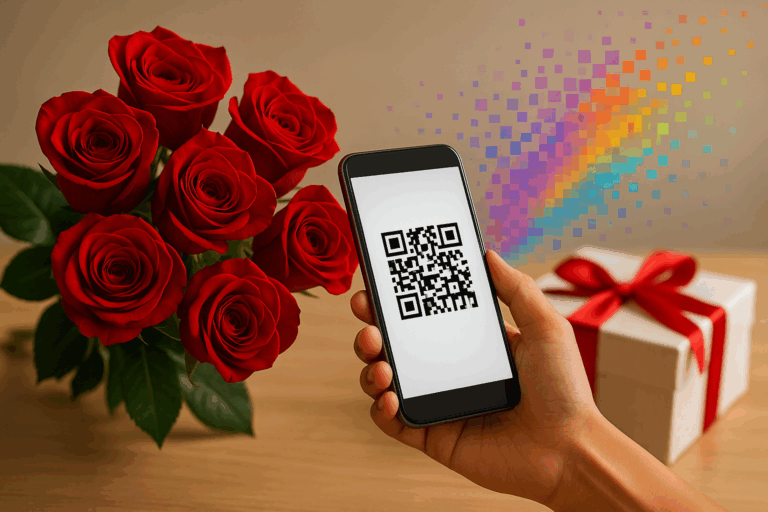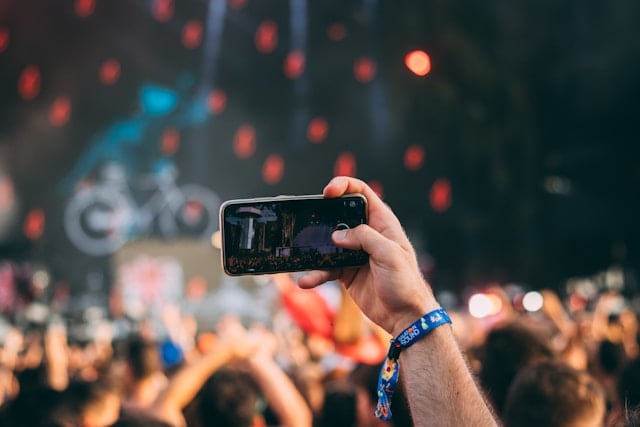User-Generated Content (UGC) is often associated with consumer-generated media, influencer or creator collaborations, or customer testimonials. The true essence of User-Generated Content (UGC) transcends conventional boundaries. It includes many new ways to improve brand-consumer interactions and community engagement. To begin, let’s define what the real definition of UGC is in it’s native and authentic form.
When marketers think of UGC, it is in its narrowest definition form. BUT, UGC goes well beyond creating content for social media. Real user-generated content is everywhere, and this broader definition of UGC includes everything from video gift notes to employee-generated content to customer onboarding feedback, training reflections, event reactions, community storytelling, and even legal video testimonials. In fact, it’s not just about going viral. It’s about capturing authentic voices, real moments, and genuine engagement wherever people experience your brand. The most valuable UGC often lives outside social feeds. It serves as a powerful instrument for trust, connection, and insight across touchpoints like websites, e-commerce, private content, and personalized one-to-one experiences.
So the real definition of UGC is: Authentic content voluntarily created and shared by real people such as consumers, employees, fans, or community members based on their genuine interactions with a brand, product, experience, or idea. Encouraging and simplifying the process for real people, especially ordinary consumers, to easily create content, particularly video, is crucial. Often, everyday customers genuinely want to share their experiences but aren’t sure how or where to begin. When brands guide these consumers, who have already purchased and interacted authentically with their products, it remains genuine UGC. However, providing free products in exchange for content undermines authenticity and should not be considered true UGC.
But what about securing proper content rights? To confidently reuse UGC across your website, ads, email, and retail touchpoints, marketers must secure permission at the start of the capture flow. Using a landing step to present concise consent language that covers scope (where you’ll use it), time (how long), attribution (how you’ll credit), and brand guidelines, then collect essentials alongside the submission. A clear, front-loaded rights flow keeps content authentic and portable while avoiding downstream approvals that slow teams.
Let’s explore some examples that redefine the definition of UGC:
Hershey’s: Crafting Emotionally Charged Connections Through Personalized UGC Video Messages
For instance, Hershey’s sought to elevate the consumer experience beyond the mere exchange of products. By partnering with BrandLens, Hershey’s introduced personalized video messages accompanying each present, turning ordinary gifts into profound emotional experiences. Through this innovative approach, Hershey’s tapped into the power of storytelling to forge deeper connections with its audience.
The process is simple yet impactful:
- The sender scans the QR code on the product box, chooses a branded video template, records a heartfelt message, and writes a secure retrieval code on the box.
- The recipient, upon opening the gift, scans the QR code inside the box, enters the secure retrieval code, and enjoys the personalized video message from the sender.


Keeping UGC on-brand and safe even at scale
Keeping UGC on-brand is one of the top priorities for any marketer. The best way to address this is by designing “branded” video capture templates and on-screen prompts that steer content toward specific stories, answers, and moments that need to be showcased. Pairing that with a lightweight review step before publishing ensures only approved clips move into social, web, or paid channels. This guidance preserves authenticity while protecting your brand voice and standards at volume.
The alternative is to brief each creator and allow them to create and submit the content. The challenges with the latter are the ability to do it at scale, and we all know that customers, micro and nano creators are not the best at following directions.
UCLA Anderson School of Management: Fostering Community and Authenticity Through Student Engagement
At UCLA Anderson School of Management, the focus extended beyond academic excellence to cultivating a vibrant and inclusive community. Leveraging UGC, the school encouraged students to share their stories and experiences through video responses. As a result, the initiative facilitated orientation and transition support for students. Additionally, it nurtured a culture of authenticity and belonging within the student body.
The campaign served multiple purposes:
- Orientation facilitation and transition support, helping students acclimate to the academic environment.
- Strengthening the sense of community by providing a platform for students to connect and share their experiences.
- Promoting authenticity and individuality through user-generated content, allowing students to showcase their personalities beyond traditional mediums.
ServiceTitan: The Definition of UGC in Employee Driven Content
ServiceTitan uses UGC to boost employee engagement and improve internal communications. Employees create and share videos with personal insights or work experiences. This initiative fosters a culture of openness and inclusivity. It makes employees feel valued and heard. Additionally, it helps reveal hidden issues or celebrate company successes.
The content can act as real-time feedback for management. This helps create a more responsive and adaptive work environment. Furthermore, shared videos can act as motivational tools, showcasing exemplary practices or offering peer-to-peer learning opportunities.
LA County Board of Supervisors: Collecting video input on weekly agenda items
Here’s another example of UGC that doesn’t involve social posting: LA County can increase civic participation by inviting citizens to submit video input on weekly agenda items. This approach makes it easier for people from all backgrounds and neighborhoods to participate in the democratic process without needing to attend meetings in person. It’s especially powerful for those who may not feel comfortable speaking up in public forums but still have valuable perspectives to share. The result is authentic, community-driven content that brings real insight into local decision-making, strengthens transparency, and builds a stronger sense of inclusion and trust between the government and its residents.
Streamlining Investment Decisions: Startups Pitches in the Digital Age
In the fast-paced world of startup funding, investors are constantly seeking innovative ways to identify promising ventures. With BrandLens, it’s possible to enable startups to deliver personalized video pitches directly to investors.
This streamlined approach not only accelerates the decision-making process but also provides a deeper understanding of each startup’s vision and potential. To see how UGC can also help your ecommerce sales, read How User-Generated Content (UGC) Can Boost Your Ecommerce Sales.
Here’s how it works:
- Campaign Creation: Investors customize the Landing, Camera, and Thank You pages for the campaign, setting guidelines and collecting essential startup information.
- Distribution: Share the campaign link or QR code with potential startups through various channels such as email, investor websites, or startup events.
- Video Pitch Creation: Startups use the Camera page to record their pitches, following on-camera prompts and questions that guide them to explain their business model and vision.
- Submission and Storage: Startups submit their pitches, which are stored in the investor’s content library on BrandLens for easy management and review.
- Review and Decision Making: Investors review pitches at their convenience, using a standardized format that allows for effective comparison and assessment.
- Feedback and Engagement: Investors use the Thank You page to provide feedback, ask for more details, or set up follow-up meetings.
How to measure UGC’s impact beyond social likes?
Measure UGC by the job it does across touchpoints. For gifting experiences, track message views and downstream sharing. For community onboarding, watch completion rates and time-to-acclimate. For employee programs, monitor participation and qualitative insights surfaced. For civic input, measure submissions and representation across neighborhoods. For investor workflows, track review speed and conversion to meetings.
UGC’s value shows up as movement in the business metrics, not vanity counts.
In summary
As we’ve seen with innovative approaches from Hershey’s, UCLA Anderson, and ServiceTitan, UGC can profoundly enhance brand-consumer relationships, foster authentic community engagement, and streamline business processes. For more creative ways to utilize UGC, check out 12 Ways to Use UGC Beyond Social Media.
Overall, these examples highlight how we must look at the definition of UGC in its broader form. They foster a genuine sense of belonging among community members and drive efficient business decisions in the competitive startup ecosystem.







